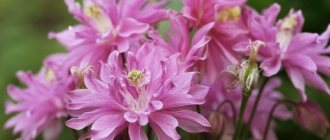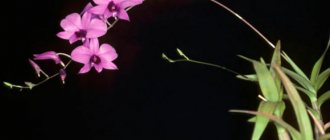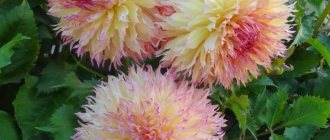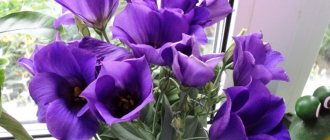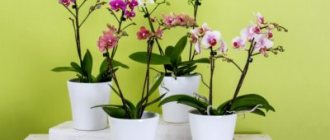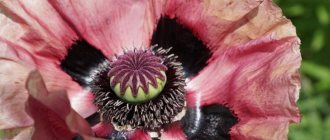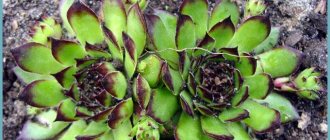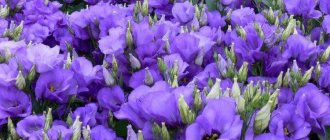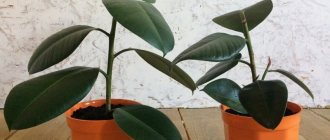Aquilegia is one of the very popular flowers in our country. Having seen it at least once, everyone wants to plant the same beauty. Moreover, with the arrival of winter (January February), it is easy to grow aquilegia on your windowsill from seeds. In our article you will learn how to do this.
Aquilegia: description, characteristics of the flower
The aquilegia flower develops within two years. The first year of life is characterized by the formation of a bud, the so-called renewal point, which is located at the base of the stem. The formation of a rosette at the root occurs in the fall, and in the spring the leaves of the rosette die off and a peduncle forms in their place. During flowering, single flowers form on the stems.
Aquilegs
The appearance of the flowers of this ornamental plant depends directly on the variety of seeds. There are such varieties as alpine, ordinary, ferruginous and many other types. You can see flowers of different colors and shapes with double petals. These can be either single-colored or multi-colored petals. The flower itself can be red, purple, pink, yellow and other shades. The background for such a quivering flower is bright openwork leaves, as well as spurs, thanks to which aquilegia is quite difficult to confuse with other flowers. The most popular varieties:
- common aquilegia, grows up to 80 centimeters, tolerates cold well, popular varieties are low-growing and terry;
- hybrid - can be found more often than others, the most famous variety is called the Snow Queen, grows to a height of about 60 centimeters;
- Siberian aquilegia, which is found in the forests of Siberia, grows up to 70 centimeters;
- fan-shaped - differs in frost resistance, grows up to 30 centimeters in height;
- the small-flowered variety is distinguished by small flowers and grows up to 30 centimeters;
- star - distinguished by openwork flowers, grows up to 80 centimeters in height.
Types and varieties
Despite the fact that aquilegia in nature has about 120 species, not such a large number of them have been introduced into culture. The following species are most often cultivated.
Alpine Aquilegia (Aquilegia alpina)
A low (up to 30 cm) plant that can grow up to 80 cm in height in rich soils. Aquilegia alpine has large flowers - up to 8 cm in diameter, different shades of blue, the spurs are short and curved. This species blooms in late June-early July;
In the photo: Alpine Aquilegia (Aquilegia alpina)
Aquilegia flabellata
Or Aquilegia Akita , a plant up to 60 cm high with trifoliate long-petioled leaves of a basal rosette, with flowers 5-6 cm in diameter with long, strongly curved spurs. There are from one to five flowers on a peduncle; they are blue-lilac in color with a white fuzzy border along the edge. This type of aquilegia is winter-hardy and grows well because it self-sows;
In the photo: Aquilegia flabellata
Common aquilegia (Aquilegia vulgaris)
The European species is 40-80 cm in height with flowers 5 cm in diameter in different shades of blue and purple, but in culture numerous varieties of this type of aquilegia are usually grown with flowers of various colors, simple, double, with spurs or without spurs. This is the most frost-resistant type of aquilegia - can withstand up to -35 ºC;
In the photo: Common Aquilegia (Aquilegia vulgaris)
Hybrid Aquilegia (Aquilegia hybrida)
Which combines various forms, most often obtained from crossing American species with Aquilegia vulgaris. Depending on the variety, it grows in height from 50 cm to 1 m. Hybrids have spurs of different lengths; there are also spurless varieties; the flowers are large, up to 9 cm in diameter, both simple and double;
In the photo: Hybrid Aquilegia (Aquilegia hybrida)
Aquilegia chrysantha
A species from North America, characterized by large, non-drooping golden flowers with long spurs. Surprisingly winter-hardy and drought-resistant. It is not yet a frequent visitor to our latitudes, but interest in it among flower growers has recently increased greatly;
- Ginseng
In the photo: Golden-flowered Aquilegia (Aquilegia chrysantha)
Canadian Aquilegia (Aquilegia canadensis)
Also a North American species with straight spurs and red-yellow flowers. Does not like dry places, but grows well in the shade. Also not yet often found in our gardens;
In the photo: Canadian Aquilegia (Aquilegia canadensis)
Dark Aquilegia (Aquilegia atrata)
European species 30-80 cm high with bluish leaves and dark purple drooping flowers 3-4 cm in diameter, short curved spurs and protruding stamens. Blooms in late May-early June. Loves partial shade. It is the base species for breeding varieties with dark flowers. Looks good in flower arrangements and cut flowers;
In the photo: Dark Aquilegia (Aquilegia atrata)
Aquilegia olympica
Originally from the Caucasus, Iran and Asia Minor, 30-60 cm in height, densely pubescent stem, large, up to 10 cm in diameter, light blue flowers with long spurs. Blooms from mid-May to mid-June;
In the photo: Aquilegia olympica
Skinner's Aquilegia (Aquilegia skinneri)
Originally from North America, winter-hardy (down to -12 ºC). The flowers are drooping, red-yellow, the spurs are straight.
In the photo: Skinner's Aquilegia (Aquilegia skinneri)
In addition to the listed types of aquilegia, which are of interest among flower growers, such species as aquilegia aquilegia aquilegia, parviflora aquilegia, blue aquilegia, bicolor aquilegia, Bertoloni aquilegia, glandular aquilegia, green-flowered aquilegia, Siberian aquilegia, ecalcarata aquilegia and some others are grown in culture.
Aquilegia - growing from seeds
Aquilegia flower
Growing aquilegia from seeds is the most famous way to grow this ornamental plant. You can either buy them or assemble them yourself. They are collected after the pods appear on the shoots. If you miss this moment, the seeds fall to the ground, forming empty small boxes. That is why, if you do not want crossbreeding, then plant aquilegias separately from other flowers. After collecting the seeds, they should be dried at room temperature.
Important! The seeds must be stored with extreme care, as they are poisonous.
Interestingly, the collected seeds have a shelf life. After two years, the seeds may not sprout. This should be taken into account when purchasing seeds.
Step-by-step photo instructions for planting aquilegia seedlings
Sowing aquilegia seeds for seedlings at home is an event that includes several important stages. How to do them correctly will be explained in the following step-by-step guide, including photos, rules and tricks.
Soil preparation
In terms of soil, aquilegia seedlings are unpretentious and undemanding, but it is better to use light and loose soil. Can be planted in universal soil for flower seedlings.
Also, to grow columbine seedlings, you can make a soil mixture with your own hands at home; to do this, mix the following ingredients in equal proportions:
- turf land;
- leaf soil;
- river sand;
- humus.
Regardless of what kind of soil you use - purchased or home-made, you need to prepare a soil mixture for seedlings . To do this, the soil should be disinfected to eliminate pathogens, pest larvae, and neutralize weed seeds. You can choose from one of the following methods:
- steaming - you need to place the soil over steam for 1-1.5 hours, stir regularly;
- calcination - you need to spread the soil on a baking sheet in a layer of 1.5-2 centimeters, place it in the oven, turned on at 90 degrees, leave for 30 minutes;
- freezing - with this method, the earth is kept at -15-20 degrees for a week, then it should move to warmth for 7 days, and then again to frost for the same amount.
After this, it is recommended to shed the soil with Fitosporin.
Advice! Before sowing seeds, it is recommended to sift the soil to improve the structure and make it more loose.
Selection of capacity
Due to the characteristics of the plant, the choice of container for planting must be approached responsibly. The fact is that aquilegia seedlings have a long tap root, so the container for growing plants must be deep and high.
For the initial planting of seeds, you can choose a deep common box or bowl, and then dive into wide, tall and deep cups (plastic or peat).
Or immediately sow the seeds in individual large containers - cups, peat tablets, plastic cassettes.
Important! The planting container for growing columbine seedlings must have drainage holes (except for peat cups and tablets)! If they are not there, then you need to do it yourself. This is due to the fact that aquilegia seedlings (like other plants) do not like stagnant water.
Seed selection
To plant aquilegia for seedlings, you need to choose high-quality seeds. It is better to buy seed in a trusted store with a good reputation and from a trusted manufacturer. It is not recommended to buy products that are too cheap. The packaging must contain detailed information (as in the photo):
Advice! It is worth buying only the freshest seeds (less than one year old), as they have the best germination rate. The ideal option is catchment seeds up to 1 year old. Or at least not older than 2 years.
You can collect aquilegia seeds yourself. Do-it-yourself collection should be done in early August. Seeds are collected from the seed pods of faded flowers. You need to cut them, dry them in room conditions, and then collect the columbine seeds by pressing on the boxes. The seed should be stored in a dry place and at low temperatures.
Seed preparation: mandatory stratification
Stratification - keeping seeds under humid conditions and low positive temperatures . The procedure imitates the natural processes occurring with plant seeds. Simply put, after flowering, the seed falls to the ground, spends the whole winter in the ground, in the cold, is saturated with moisture, and then in the spring, when optimal conditions arrive, it, completely ready, begins to awaken and germinate.
Aquilegia seeds need stratification , since they are difficult to germinate, and with the help of the procedure the quantity and quality of seedlings increases: they are stronger and more friendly, and the seedlings are healthier and stronger.
Of course, you can sow the seeds of a watershed without prior stratification, but the seedlings will most likely disappoint you, if they appear at all...
Note! The duration of stratification is 4-5 weeks. The optimal temperature is +1-4 degrees, that is, ideal conditions can be found in the refrigerator.
Stratification of aquilegia seeds can be done in 3 ways:
1) On cotton pads. To do this, place one cotton pad on some kind of bowl, place seeds on the disc, and moisten it with a spray bottle.
Cover with another disc on top, place the cotton pads in a plastic bag and put them in the refrigerator.
2) In wet sand. The scheme is quite simple - you need to mix the seeds with a small amount of clean, calcined river sand, and also moisten them with a spray bottle.
And then wrap it in a bag and put it in the refrigerator.
3) After sowing in the ground. For this method, you need to sow aquilegia seeds in the ground according to the correct pattern (more on this below). And then, after planting, cover the container with a lid or film and put it in the refrigerator. The main trick and convenience of this method is the stratification of catchment seeds - after the expiration date, you do not need to sow the seeds, but you can simply rearrange them in optimal conditions.
After 4-5 weeks of stratification, you need to get the seeds, provide full care and optimal conditions - lighting, temperature, watering.
Important! If the seeds germinate before the specified optimal period for the procedure, they must be removed from the refrigerator, removed the lid or film and placed in a warm and bright place.
Direct sowing
After all the preparatory activities, you can begin direct planting at home. Step-by-step photo instructions for sowing aquilegia seeds for seedlings will come to the
1) Place a layer of drainage on the bottom of the container, its thickness is 1.5 centimeters. You can put expanded clay.
2) Fill the container with prepared soil, leave a small distance between the edges of the container and the surface of the soil.
3) Moisten the soil with a spray bottle with warm, settled water.
4) Sow the aquilegia seeds evenly over the surface of the soil, the optimal distance between them is 2-3 centimeters.
As you can see in the photo, the columbine seeds are relatively small:
Due to their size, it is convenient to sow them with a toothpick.
Or tweezers.
But you can simply transfer the seeds by hand.
5) Now you need to sprinkle the seeds on top with soil, the thickness of the soil layer is 5 millimeters, no more!
6) Water with a spray bottle, again with clean and settled water.
7) Create a mini-greenhouse - just cover the container with soil and seeds with a lid, glass or film.
Important! Further actions after planting will depend on the stratification: if you have already stratified the seeds, then the container should be put in a warm place with a temperature of +18-20°C, if you want to stratify the seeds after planting, then simply put the container in the refrigerator for 4-5 weeks .
Aquilegia: planting seeds
Heliotrope flower - growing from seeds
To figure out how to plant aquilegia from seeds, you do not need to be an experienced gardener. To plant these seeds, it is worth choosing deep containers. If you don’t want to bother with plastic or wooden boxes, then you need to find containers with which you can plant the seedlings directly into the ground. For example, paper bags. Then planting will be easier, and there will be no need to be afraid that the roots will be damaged during replanting.
Containers for planting seeds
For aquilegia you do not need to select a special substrate. It is enough to take a standard substrate or a simple soil mixture.
How to sow aquilegia seeds
Planting aquilegia seeds for growing seedlings involves several stages:
- The containers are thoroughly washed with running water.
- A drainage layer 1-2 cm thick is placed at the bottom of the container.
- Sifted soil is placed on top so that the edge remains free. The soil is not added 2-3 fingers to the top.
- The earth is moistened with warm, settled water from a sprayer.
- The columbine seeds are placed at a distance of 2-3 cm from each other. If it is uncomfortable to do this with your hands, you can use a toothpick or tweezers.
- Sprinkle the grains on top with a thin layer of earth, no more than 0.5 cm.
- The crops are sprayed with a spray bottle. You cannot pour water from a bottle or other container - the soil and seeds are washed away.
- The planting container is covered with a lid or plastic wrap to create a greenhouse effect.
- The container with seedlings is placed in a warm (at least +18°C) and well-lit place.
- If stratification method 3 was chosen, then the container is placed in the refrigerator.
When carrying out planting work, precautions must be taken. An increase in heart rate, nausea, diarrhea or any other symptoms is a reason to immediately consult a doctor.
Before the first shoots of the catchment appear, the film or cover is removed once a day and the crops are ventilated for 20-30 minutes, and the moisture formed on the glass or polyethylene is removed.
Conditions necessary for growing aquilegia from seeds
In order for the seeds to germinate successfully, you need to adhere to certain growing conditions. You don't need to do anything special. Aquilegia loves light, humidity and an air temperature of at least 15 degrees. Also, for better climbing, the boxes with the plant need to be covered with film.
Note! Direct sunlight is not acceptable for growing aquilegia.
Seedlings need watering. To do this, you will need a spray bottle and water at room temperature.
If all favorable conditions for the flower are met, the first leaves should appear on the stems. Then it’s time to remove the film and plant the seedlings in separate containers.
Possible diseases
The most common diseases of aquilegia are gray rot, powdery mildew and rust.
Powdery mildew
Signs of this fungal disease are a characteristic white-gray coating on the leaves, under which they acquire a brown tint, curl and die quite quickly. A good way to combat this problem is a solution of colloidal sulfur in combination with green soap.
Rust
It appears as a characteristic spotting. The affected parts of the plants must be immediately destroyed, however, the plant can be saved. For spraying, it is recommended to use a soap solution with the addition of copper sulfate or any special sulfur-containing preparations.
Gray rot
Unfortunately, it cannot be treated with any drugs. Diseased plants must be collected and burned, and the surviving ones, if possible, transplanted into new soil.
When and how to plant seedlings in open ground
The seedlings are ready for planting. To transplant it into open ground, you need to make sure that there will be no frost, since aquilegia is afraid of the cold. Once the temperature has stabilized within 15 degrees, a suitable location is selected.
Note! Moist, loose soil is most suitable for aquilegia.
Before planting, the area where the flower will grow needs to be dug up and fertilized. Next, small depressions are made at a distance and flowers are planted. After planting, you need to make sure that direct rays do not fall on the plants.
Transplanting aquilegia into the ground
Plant care
Caring for aquilegia does not require much time. Basically, these are standard procedures, such as watering, weeding and loosening the soil.
A powerful root system makes the plant resistant to prolonged absence of water.
To learn how to grow aquilegia, read the material below.
Weeding and loosening the soil
To prevent a crust from appearing on the soil, the soil must be loosened after rain or watering. If this is not done, the dried out topsoil will prevent air from reaching the roots.
Watering
The catchment has a developed root system, it is quite unpretentious in watering, but nevertheless loves water. Water in small portions as the soil dries out. The best option is watering that simulates rain. Irrigation systems will help with this.
The soil
Every year the plant needs to be supplemented with fresh soil. This is required both to renew the soil and to hide the roots that are crawling out. Many species grow well among rocks.
Top dressing
Caring for the watershed during the growing season requires combining watering with fertilizing with organic or mineral fertilizers. It is best to do this three times - in May, June and after flowering.
If the plant is fed correctly, you can achieve flowering throughout the summer.
How to care for aquilegia after flowering?
After the aquilegia has faded in the garden, the stem must be cut back to a rosette of leaves. If the plant is healthy, it is used as compost. It is better to burn diseased specimens. If this is not done, there is a risk of contamination of the soil and other plants.
The time after flowering is perfect for planting aquilegia or doing division.
Winter care
As mentioned earlier, columbine roots eventually protrude above the soil surface. To prevent the plant from freezing, it must be mulched before winter and the roots covered with fresh soil. It is better to start preparing for winter in the fall.
Trimming
To avoid random seed dispersal, the catchment area must be trimmed. This procedure is carried out immediately after flowering and helps preserve the decorative appearance of the plant.
How to grow aquilegia from seeds
Small aquilegias require special care. To ensure that other vegetation does not interfere with their growth, the flowers need to be weeded regularly. This is also necessary in order to loosen the soil around the stem, especially after heavy rainfall.
Young aquilegias need to be fertilized with minerals, which should be done mainly in the summer.
Aquilegia will begin to bloom fully in the third year. To prolong its flowering, you need to pick flowers that have bloomed.
Description of the plant
The peculiarity of the catchment is that not only its flowers are decorative, but also its leaves.
The plant grows no higher than one meter in height (except for some hybrid varieties). Drooping flowers of various shades grow on an erect, slightly branched stem - blue, yellow, white, crimson and purple. There are also bicolor flowers that combine several shades. The root system is no more than 50 cm, taproot. The root is thick and well developed.
A description of aquilegia would be incomplete without mentioning the leaves. They are collected in a basal rosette, which retains its decorative appearance until it withers.
The affectionate name for this flower is Orlik. It is also called doves, boots, bells and columbine.
Aquilegia is a perennial with three types of spurs: straight, curved or ring-shaped, and without them at all.
The catchment is known for active self-seeding. Having transplanted a young plant, you should expect flowering no earlier than in the second year.
Planting and caring for aquilegia in Siberia
Since aquilegia can be found in nature in all regions of Siberia, it is very easy to grow it in this climate. In itself, it is unpretentious, frost-resistant and not afraid of the cold.
Siberian aquilegia
To plant aquilegia in Siberia, it is worth remembering that it can be found wild in a birch forest, where there are better conditions for it. That is, in the shade, where there is loose, moist soil.
For Siberia, no special conditions are needed for planting such an ornamental plant as a catchment. It will thrive in soil rich in humus, and with proper care it will bloom for many years.
When to plant aquilegia seeds for seedlings, in what month
Very often, summer residents and gardeners who are starting to grow flower crops have a question about when to plant the catchment for seedlings. Suitable planting dates are March and April .
It is recommended to take into account the regional characteristics of the climate in which you live:
- In the central zone (including the Moscow region), the optimal time for sowing aquilegia is in the middle and end of March;
- In the south of Russia - you can sow at the end of February or at the beginning of March;
- In the Leningrad region, Siberia and the Urals , it is better not to rush into the procedure and plant the crop in mid or late April.
You can also choose the time for landing according to the Lunar calendar 2022 :
- Favorable days: in January: 1, 10, 11, 15, 16, 19, 20;
- in February: 7, 8, 12, 13, 14, 15;
- in March: 10, 11, 15, 20, 21, 24, 25.
- Unfavorable days: in January: 2, 18th;
- in February: 1, 16;
- in March: 2, 16, 17, 18, 31.
Aquilegia: reproduction
Reproduction of the catchment occurs by seeds, as well as by dividing the bush and cuttings. The young bush can be easily divided into several parts and planted. But old bushes are difficult to tolerate division, because with this method of propagation, it is very easy to damage the roots. If this happens, the plants become sick.
Note! Most often, propagation of aquilegia is carried out using seeds. Depending on the time of year, they can be sown both as seedlings and in open ground.
Also in open flower beds, propagation can occur by self-sowing. If the seeds are not collected in time, they fall off and are sown throughout the area. To prevent crossings and unnecessary bushes, most of the seed pods need to be cut off.
Diseases and pests
Such beauty sometimes requires your protection
Aquilegia is susceptible to disease. It may also be attacked by pests.
- Due to excess moisture and stagnation of water, the roots of the plant will begin to rot . It is necessary to reduce the intensity of watering. For wet soils. Before planting, be sure to lay a drainage layer.
- Lack of sun causes an attack of powdery mildew . The leaves become covered with a white coating, turn red, and fall off. If you see it in time, it is enough to tear off the damaged leaf and ensure the flow of sunlight. In case of mass infection, special products sold in flower shops will help.
A sulfur solution helps get rid of it. She needs to be treated 2 times a week.
- Aquilegia can develop gray mold . Its signs are dark watery spots. You can get rid of it using a solution of potassium permanganate or fungicides.
- Attacks by aphids or caterpillars can be devastating. They will eat the bush in a few days. Foundationazole helps for prevention.
By mid-July the bushes begin to turn yellow. This is a natural process. You need to cut off the dying leaves. By autumn, new ones will grow in their place.
Propagation by seeds
The easiest way to propagate a catchment is by seeds. For a good harvest, they need to be collected on time and stored correctly. Seeds can be planted either in the spring for seedlings, or in the fall directly into the ground.
For good germination, seeds must undergo stratification. Stratification is the effect of low temperatures on seeds. Therefore, if the collected seeds are lying before planting, then in mid-spring they are mixed with soil and placed in the refrigerator. It is also possible to sprinkle the seeds with snow. .
Seeds
SEED PREPARATION
Initially, it is necessary to subject the seeds to stratification. Carefully place them in a cloth that has been previously soaked in water. This manipulation is also done in wet sand.
Options for stimulating seed growth:
- They are sown in a box and then put in the refrigerator or taken outside, where the seeds are carefully sprinkled with snow. Make sure that the temperature is not lower than 0-5C;
- seeds should be treated by warm stratification. Before planting, they are kept at a temperature of at least +35C;
- The seeds are poured onto a hard, flat board or table and rubbed on top with sandpaper.
What to do with aquilegia after flowering
Aquilegia has faded, what to do next:
- stems that have bloomed and lost their appearance need to be trimmed. They are cut off mainly to the very sockets;
- what is cut can be used for compost if the flower was healthy, but if the bush was sick, then it is better to take the remains away, and it is better to burn them so that healthy plants are not infected;
- the catchment has flowered - it’s time to collect the seeds by cutting the seed pods from the stem;
- Also, if you propagate a plant by division, then this should be done exactly when flowering has stopped.
How to properly care for aquilegia
Floriculture specialists are convinced that correctly carrying out the seedling method is not enough to obtain a beautiful flowering garden.
Despite the unpretentiousness of aquilegia, it requires another year of special care. Reason: flowering and ripening occurs only in the 2nd year.
Watering and fertilizing
During the first 14 days, watering of aquilegia is carried out frequently so that the plant takes root. Further, the frequency of watering is reduced.
Carry out as necessary to prevent the soil from drying out. Fertilizer application is planned 14 days after transplantation to a permanent location.
Nitroammophoska or other nitrogen-containing mixtures are used. It is enough 2 times during the growing season: with nitrogen in early spring after transplantation and during the formation of buds. The second time they are fed with potassium-phosphorus substances.
Trimming
Peduncles are removed only after wilting. This is a necessary measure, since after flowering the buds continue to absorb useful micro- and macroelements. To obtain seeds, only strong, well-developed flowers are left.
Disease and pest control
Aquilegia has strong immunity, but is susceptible to fungal infections such as powdery mildew. You can avoid it if you treat it with Fitosporin or colloidal sulfur for prevention.
If there is a risk of gray mold infection, you will need to completely remove and burn the infected plants.
Often aphids, nematodes and spider mites infect the plant. Pests can be controlled using insecticides. It is recommended to use Actellik.
Mulching
Aquilegias are mulched after planting in open ground. This is enough to replenish the soil with the necessary substances. This manipulation also prevents the appearance of weeds.
Next, only loosening is necessary to improve air exchange and oxygen supply. Peat/compost/rotted sawdust is used as mulch.
Preparing for winter
In order for the plant to safely overwinter and please the gardener next spring, it is worth carrying out the following manipulations:
- pruning with garden shears. The blade is treated with manganese solution;
- the soil is loosened and mulched;
- remove weeds and leaves;
- cover with insulation (if severe frosts are expected).
Propagation by cuttings
One of the ways to propagate aquilegia is by cuttings. Cuttings are much easier to do than fiddling with seeds and seedlings.
There are certain rules for cuttings:
- in the spring, before the leaves bloom, you cut off the young shoots and treat the cut with a product that stimulates growth;
- The cut shoot is planted in the ground or placed in a container and covered.
For the cutting you need to choose a suitable place:
- the cuttings, like the seedlings, are planted in soil with humus;
- You need to choose a place in the garden that is dark and has sufficient moisture.
Note! The planted cuttings need to be watered without removing the film from it, and within a month it should take root. Once the cutting has taken root, it can be transplanted into a prepared place in the flowerbed.
General information
Aquilegia is a herbaceous perennial from the buttercup family. The plant is also known as columbine, orlik, and columbine. There are about 120 species, of which 35 are cultivated at home.
The flower has been known to people for a long time
In the Middle Ages it was depicted in paintings, it signified the presence of the holy spirit. It was mentioned in literature, for example, Shakespeare in Hamlet described how Ophelia gives a columbine flower to her brother Laertes.
The height of the ground part of aquilegia reaches 1 m. The root has a rod shape and many branches. It can grow up to 50 cm deep.
A renewal bud is formed at the base of the shoot every year. A socket is formed from it. From which leaves and flower stalks emerge.
The leaves emerging from the rosette are trifoliate and grow on long roots. The stem leaves are tightly packed and have no petioles.
Flowers near the catchment area are solitary. There can be up to 12 of them on one peduncle. The inflorescence is a panicle. It is quite rare and drooping. The diameter of the flower reaches 10 cm, but this, like the color, depends on the variety.
Many columbine species have spurs on the flower, which store nectar.
There is a classification of plants according to them:
- Without spurs
- With straight spurs
- With curved spurs
The flowering period lasts about a month. It falls in May or June. But there are varieties that bloom until frost.
After flowering, the fruit ripens - multi-leafed. Small black seeds ripen in it. Their germination persists throughout the year. Self-sowing of seeds is possible.
You need to be extremely careful with aquilegia seeds! They contain poison. If accidentally ingested, it will cause severe poisoning.
Reproduction by dividing the bush
The division method is used only for plants that have been growing for at least three years. This is done in early autumn so that the plant has time to take root before frost sets in.
The procedure for dividing the bush:
- a bush is dug up;
- the root of the bush is divided with a knife into as many parts as possible;
- the cut is lubricated with activated carbon;
- the bushes are planted in a new place with suitable soil and watered well;
- The surface around the bush is covered with mulch.
Pruning the plant after flowering, preparing for winter
When the plant has finished blooming, remove all flower stems, as they have already lost their decorative beauty. They also inspect the entire bush at the same time - remove dry and damaged leaves. You can also cut off the entire above-ground part of the bush, because with the arrival of spring new stems will grow.
It is also very important to check the base of the flowers; in mature plants (over 3 years old), roots begin to emerge from the soil. To prevent the plant from freezing in winter, all roots protruding from the ground are covered with compost, pre-mixed in equal proportions with manure. Such a shelter will protect the roots well from severe frosts and serve as additional fertilizer.
With such a variety of aquilegia varieties, every gardener will be able to choose a variety that will decorate his plot with delightful flowers. You can choose several types of this plant and create a fabulous composition that will decorate your garden or local area.
How to transplant aquilegia to another place
When transplanting, you must follow certain rules. Need to:
- dig up a bush for replanting;
- choose a suitable place for transplantation;
- loosen the soil in this place and water it;
- plant the bush without shaking off the earthen lump from the rhizome;
- water and compact the soil around the plant.
Note! As a result, we can say that aquilegia is a beautiful, unpretentious flower that does not require special care. In order to grow a watershed in a flowerbed, you need to follow a few simple rules.
Namely:
- plant the flower in soil enriched with humus;
- protect the plant from direct sunlight;
- fertilize the soil with mineral additives;
- feed the plant with vitamins;
- make the transplant on time.
And the flowers will not get sick, and from year to year they will delight the eye with lush blooms.
How and when to pick aquilegia seedlings
When should you pluck aquilegia seedlings? The optimal time for the procedure is when the seedlings have 2-3 true leaves , this stage occurs approximately a month after planting.
It is very important to plant at the recommended time, before the roots grow and become crowded, because seedlings quickly grow a root system, and they also have a long tap root.
The soil can be used the same as for sowing. a container for picking that is voluminous and only individual cups - plastic, peat or large plastic cassettes . The new container must have drainage holes .
Picking aquilegia should be performed according to the following scheme:
- Water the plants (preferably an hour to half an hour before the procedure).
- Fill the new container with soil.
- Use your finger or a stick to make a hole in the center of the new container.
- Pick up the seedling, for example, using a wooden stick or a small spatula (there is no need to destroy the earthen ball around the seedlings or shake off the soil).
- Transfer the plant to the hole.
- Lightly press the soil around the plant with your fingers.
- Apply moderate watering using a syringe or spray bottle.
Note! You should care for aquilegia seedlings after picking in the same way as before the procedure!
Features of aquilegia
The development of this plant consists of two stages. At the first stage, a renewal point grows near the stem. In the fall, when the aquilegia fades, a rosette forms from it. In the spring, the second stage of development begins and then the rosette changes foliage, and a peduncle appears from it, on which flowers with stem leaf plates grow until the end of summer.
The color and size of single flowers are directly determined by the type of aquilegia, of which there are a whole variety of colors, respectively. Flowers of the American and European types of aquilegia are characterized by a spur, which is an outgrowth of hollow petals with nectar inside. Aquilegias from China and Japan do not have spurs.
The fruit of the aquilegia is a multi-leafed plant containing poisonous dark-colored seeds with a germination period of about 12 months.
Pests
The most common uninvited guests are nematodes, cutworms, the ubiquitous aphids and spider mites. You can fight the last two with the help of yarrow paste, karbofos and actellik. The situation is much more complicated with nematodes, which cannot always be controlled with the help of insecticides. Experienced gardeners recommend transplanting healthy flowers to another place, and in the area where the flowerbed was laid out, planting garlic, onions, cereals or other crops that are not affected by nematodes. Affected plants must be burned.
Aquilegia: growing conditions, choice of place for planting/transplanting
Aquilegia is an unpretentious plant. However, you need to care for it correctly. It is important to remember that the catchment has a fairly long tap root system, so it can independently provide itself with moisture. True, because of this feature, problems often arise with transplanting an adult plant, because such roots do not take root well in a new place. There is only one way to help the watershed survive the “housewarming” - by shading it for a while. Transplanting aquilegia works best in the fall.
The plant actively spreads by self-sowing and quickly cross-pollinates, so it is better not to plant different varieties in one place, but to place them in the corners of the garden. Enthusiastic summer residents write out the varieties they especially love from catalogs and grow them with seeds.
Aquilegia does not tolerate excessive waterlogging, which leads to a disease such as gray rot. But the plant is shade-tolerant and can bloom profusely in partial shade or openwork shade. Usually the columbine blooms for 2-3 weeks, but if you pick off the faded flowers, you can extend the flowering until autumn. However, we do not recommend overusing this method, as the plants are greatly weakened.
Aquilegia in landscape design
Aquilegia is almost never seen in sunny flower beds. It is mainly planted in the shade of houses and buildings or used to decorate garden trees.
Aquilegias are also successfully combined with other shade-loving flowers into single compositions.
Aquilegia with other cultures
Aquilegias are often used to decorate decorative ponds. With this arrangement, plants are planted with other crops, creating a beautiful coastal flower garden. Aquilegia takes root well even on alpine hills, where low-growing varieties are placed in the spaces between the stones.

